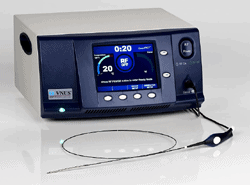Endovenous radiofrequency ablation, also known as RFA, is a treatment for varicose veins in the legs, a condition that affects a large number of adults. This procedure uses heat to close off the larger superficial veins, those closer to the surface of the skin. This includes the great, small and accessory saphenous veins.
The procedure is less invasive than other varicose vein treatments such as vein stripping, and requires only a tiny skin puncture. Radiofrequency ablation takes about 45 to 60 minutes per leg. Your doctor can perform it in the office or at an ambulatory surgery center using local anesthesia.
Endovenous radiofrequency ablation may also be used alongside other procedures such as sclerotherapy and phlebectomy for treating the smaller varicose veins in the legs.
How is endovenous radiofrequency ablation performed?
The general procedure for treating varicose veins using endovenous radiofrequency ablation follows these steps:
- Before the procedure, your doctor will use ultrasound to map the veins to be treated. A mark is made on the skin to show where your doctor will make a small puncture (incision) to access the vein. This is often just above or below the knee.
- The skin of the leg is sterilized to reduce the risk of infection. A superficial local anesthetic is applied to the skin around the knee so you don’t feel pain when your doctor makes the small incision.
- Once the skin is numb, your doctor will make an incision in the skin at the location that was marked before. Using ultrasound as a guide, your doctor will then insert a small tube (catheter) into the vein to be treated.
- A local anesthetic is injected into the tissues around the vein, and along the entire length of the vein. This keeps you from feeling pain during the procedure. The anesthetic also compresses the vein and prevents heat created by the radiofrequency device from moving too far beyond the vein.
- When the radiofrequency device is turned on, it heats and closes the vein from the inside. The vein is treated in segments, as the catheter is pulled slowly out of the vein.
- When the entire length of the vein has been treated, the catheter is removed. Your doctor will use ultrasound again to make sure the treated vein was closed properly.
- The collapsed vein will close and form scar tissue. Over time the vein will fade away. When this happens, blood will naturally flow to other healthier veins in the leg.
Initial indicators of venous insufficiency
This could be an early indicator of venous insufficiency if you have noticed your legs and ankles swelling and have ruled out edema (water retention). Other symptoms like scaly, black spots on your legs and ankles, intense throbbing pain, or persistent discomfort in your legs could also be present. Finally, varicose veins are a common sign of venous insufficiency.
Venous insufficiency’s frequent cause
Your blood should flow strongly and steadily from your heart to your extremities and back throughout its whole circuit. The most common cause of venous insufficiency is when the small valves inside your veins become damaged and cease functioning properly.
When the valve is compromised, blood returns to the heart more slowly and pools in the vein. The end result is a leg-protruding, ropy-looking vein that is red or purple and may feel hot or painful.
L
What Help Can Radiofrequency Ablation Provide?
Because it treats the problematic vein from the skin’s surface, radiofrequency ablation is a well-liked therapy option for varicose veins. In other words, our staff can accomplish notable outcomes without the risks of surgery by using radiofrequency ablation.
Can RFA be used to treat varicose veins in patients with skin conditions, such as eczema or psoriasis?
Radiofrequency ablation (RFA) is generally considered safe for patients with skin conditions such as eczema or psoriasis. However, it’s important to consult with a healthcare provider who is familiar with your specific skin condition before undergoing RFA treatment for varicose veins.
Will I need to have any imaging tests before RFA treatment?
Yes, before undergoing Radiofrequency Ablation (RFA) treatment for varicose veins, you will likely need to have imaging tests to evaluate the veins and determine the best course of treatment. The most common imaging test used for this purpose is a duplex ultrasound, which allows healthcare providers to see the structure of the veins and assess blood flow.
How does RFA compare to surgical treatments for varicose veins?
Radiofrequency Ablation (RFA) and surgical treatments, such as vein ligation and stripping, are both used to treat varicose veins, but they differ in several ways:
- Procedure: RFA is a minimally invasive procedure that uses heat generated by radiofrequency energy to close off varicose veins. Surgical treatments, on the other hand, involve making incisions in the skin to physically remove or tie off the affected veins.
- Anesthesia: RFA is usually performed under local anesthesia, while surgical treatments may require general anesthesia or regional anesthesia.
- Recovery: RFA typically has a shorter recovery time compared to surgical treatments. Patients can usually resume normal activities within a few days after RFA, whereas recovery from surgery may take a week or more.
- Scarring: RFA leaves minimal scarring, as it only requires a small incision or needle puncture. Surgical treatments may leave more noticeable scars due to the larger incisions required.
- Effectiveness: Both RFA and surgical treatments are effective in treating varicose veins, but RFA may be associated with fewer complications and a lower risk of recurrence.

